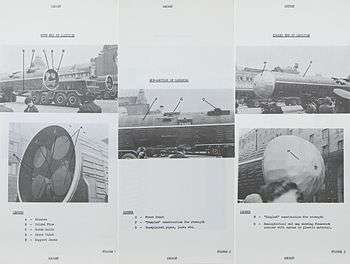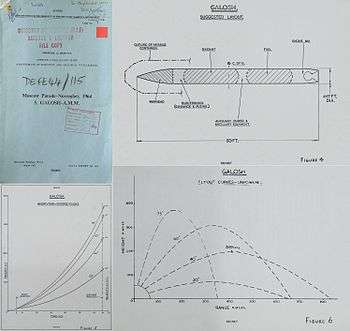ABM-1 Galosh
The ABM-1 Galosh[4] (Soviet designation A-350 GRAU 5V61)[5] was a Soviet, nuclear-tipped surface-to-air anti-ballistic missile.[6] The Galosh (NATO reporting name, formerly SH-01) was a component of the A-35 anti-ballistic missile system.[7] Its primary mission was to destroy U.S. Minuteman and Titan intercontinental ballistic missiles targeting Moscow.
| ABM-1 Galosh | |
|---|---|
A Galosh anti-ballistic missile launcher | |
| Type | anti-ballistic missile (ABM) |
| Place of origin | Soviet Union |
| Service history | |
| In service | Phase 1: 1972 A-350 Phase 2; 1974 A-350R (Design 1962) Phase 3: 1978 A-35M System |
| Used by | Russia |
| Wars | Cold War |
| Production history | |
| Manufacturer | TsNPO Vympel and NIIRP A-35/A-35M Systems Designer: K. B. Kisunko A-350/A-350R Missiles Designer: P. D. Grushin |
| Unit cost | unknown |
| Specifications | |
| Mass | 32,700 kg |
| Length | 19.8 m |
| Diameter | 2.57 m |
| Warhead | 2–3 Megaton A-350 thermonuclear weapon |
Detonation mechanism | unknown |
| Engine | solid fuel rocket motor (3) w/ RD-O15T ramjet First stage: 4 x solid rocket boosters RDTT 5S47[1] Second stage: 5D22 liquid rocket[2] |
| Wingspan | 6.0 m |
Operational range | 320–350 km |
| Flight ceiling | 120 km exosphere |
| Flight altitude | unknown |
| Maximum speed | Mach 4 |
Guidance system | Radar Command guidance |
Launch platform | A-35 Aldan[3] |
The ABM-1 was introduced during the 1960s with mechanically steered semi-active radar guidance. It contained a high-yield nuclear warhead, comparable to the U.S. Nike Zeus.
The ABM-1B (Soviet designation A-350R) was introduced with the advanced A-35M missile system and became operational during 1978. This system was tested at the Sary Shagan Launch Facility with five test flights during 1971, 1976, and 1977, with two more tests during 1993 and 1999.[8]
The next generation of missiles, introduced with the A-135 ABM System, were the ABM-3 Gazelle (1970s), and ABM-4 Gorgon (1980s).[4]
Design
.jpg)
The ABM-1 Galosh was a three-stage solid-fueled design with a range of over 300 kilometers. The ABM-1B was improved with a restartable liquid-fueled third stage. This gave a much improved post-launch and re-targeting capabilities. The Galosh are launched from above-ground launchers. [9]
The missile design was done by MKB Fakel's Chief Designer Petr Grushin.
The system had multiple radars during the different phases including the Pill Box and Hen House early warning systems, and the Dog House and Cat House target acquisition systems. The A-35 with radar was designed by Chief Designer K. B. Kisunko.[7]
Radar systems
The idea for this system was to protect Moscow from nuclear attack by the United States. The Russian government began studies during 1958 with preliminary designs from General Designer K. B. Kisunko. Further designs and development were moved to TsNPO Vympel. Radar systems were tested with Duna-3 single direction search radar and the Dunay-3U omni-direction 360-degree search radar, designed by V. P. Sosulnikov and A. N. Musatov, respectively. A more advanced system of radars were included, the Don-2N System; consisting of the 6000 km long-range early warning radars, (NATO code names Pill Box and Hen House), and the 2800 km short-range target acquisition radars (NATO codenames Dog House and Cat House).[7]
Missile warhead
The A-350 developed through a period of growth and modifications. Configurations included an improved A-350Zh with tests during 1973. Eventually, the design changed again with radiation-hardened cases and became the A-350R for Phase 2 deployment in 1974.
Construction
The construction of the ABM-1 system began during 1962 with 16 primary sites including command post, radar installations and firing complexes for 8–16 missile launchers. Some of the existing sites of the old SA-1 Guild were modified. Some known locations are: Naro-Fominsk, Olenegorsk, Skrunda, Angarsk, Nikolaeyev, and Sary Shagan.
One of the Dunay radar (NATO Code : Dog House) phased array radar systems was located at Naro-Fominsk. This system is comparable to the US's PAVE PAWS radars of the Sentinel and Safeguard ABM programs.
The construction plan changed a number of times, varying the locations, sectors or quadrants, and number of launchers. The system finalized at 8 sites with total of 64 launchers, with 4 major radar centers completed.[9]
Advanced A-35M system (ABM-1B)

With on-going advancements in the ABM system, radars, missile and warheads, the evolution of the ABM-1 Galosh became the ABM-1B Galosh. The "M" for modernization, was brought on through the advanced developments at 10 different Russian institutes. One primary upgrade was in the Dunay-3U radar systems enhanced with a dedicated sector search functionality. Along with other upgrades, actual air tests were performed with different configurations between 1976 and 1977. Phase 3 of the Galosh went on-line in 1978.[7]
See also

- Treaties
- Related US missiles
- Nike Zeus
- Sprint (missile)
- LIM-49A Spartan
References
- Astronautix: 5S47 Solid Rocket Motor Archived 11 November 2011 at the Wayback Machine Accessed: 29 Dec 2011
- Astronautix: 5D22 Solid Rocket Motor Archived 11 November 2011 at the Wayback Machine Accessed: 29 Dec 2011
- astronautix.com: A-35 Archived 11 November 2011 at the Wayback Machine Accessed: 29 Dec 2011
- "NATO Designation-systems Index: Soviet Anti-ballistic Missiles (ABM)". Retrieved 14 November 2014.
- "Some important Soviet solid fuel missiles". www.b14643.de.
- Wonderland.org: ABM-1 Archived 9 February 2008 at the Wayback Machine
- "A-35". Encyclopedia Astronautica. Archived from the original on 18 July 2008. Retrieved 25 August 2008.
- "Astronautix: Sary Hagan". Retrieved 14 November 2014.
- "Federation of Scientists: ABM-1". Retrieved 14 November 2014.
- Notes